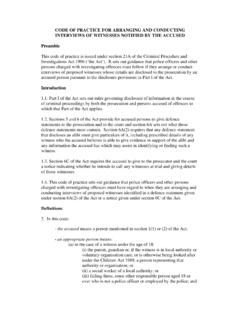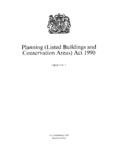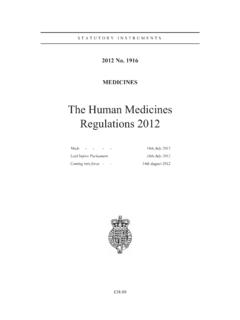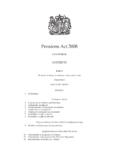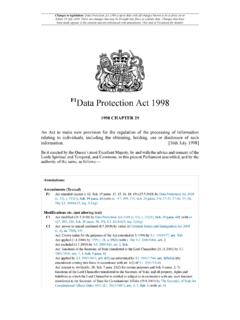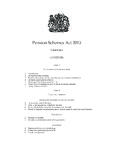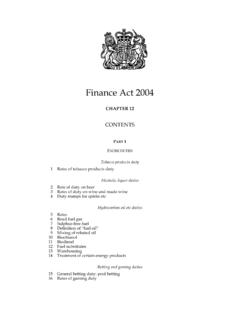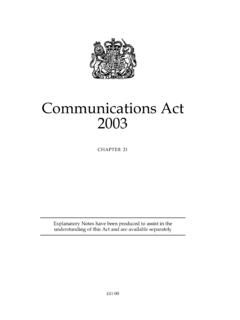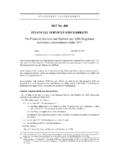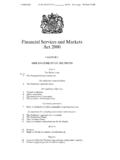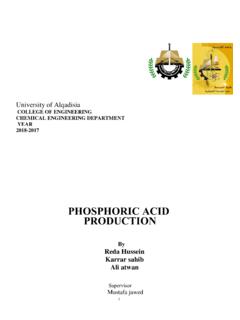Transcription of The Construction (Design and Management) Regulations …
1 Changes to legislation: There are currently no known outstanding effects for the TheConstruction ( design and management ) Regulations 2015. (See end of Document for details)STATUTORY INSTRUMENTS2015 No. 51 HEALTH AND SAFETYThe Construction ( design and management ) Regulations 2015 Made - - - -22nd January 2015 Laid before Parliament 29th January 2015 Coming into force - -6th April 2015 The Secretary of State makes these Regulations in exercise of the powers conferred by sections15(1), (2), (3)(a) and (c), (5)(a), (8) and (9), 80(1) and (2)(c) and 82(3)(a) of, and paragraphs 1(1)and (2), 6 to12, 14, 15(1), 16, 18, 20 and 21 of Schedule 3 to, the Health and Safety at Work 1974 F1 ( the 1974 Act ).The Regulations give effect without modifications to proposals submitted to the Secretary of Stateby the Health and Safety Executive ( the Executive ) under section 11(3) of the 1974 Act submitting those proposals to the Secretary of State, the Executive consulted the bodiesthat appeared to it to be appropriate as required by section 50(3) of the 1974 Act appears to the Secretary of State that the modifications to the instruments marked with anasterisk in the table in Schedule 5 are expedient for the purposes of section 80(1) of the 1974 also appears to the Secretary of State not to be appropriate to consult bodies in respect of thosemodifications for the purposes of section 80(4) F4 of the 1974 Section 15(1) was substituted by paragraph 6 of Schedule 15 to the Employment ProtectionAct 1975 ( ) and amended by 2002/794.
2 Section 15(2) and (3)(c) was amended by paragraphs 1and 5 of Schedule 12 to the Energy Act 2013 ( ).F2 Section 11(3) was inserted by 2008 50(3) was amended by paragraph 16 of Schedule 15 to the Employment Protection Act 1975( ), 2008/960, paragraphs 4 and 6 of Schedule 7 to the Health and Social Care Act 2012 ( ),and by paragraphs 1 and 11(1) of Schedule 12 to the Energy Act 80(4) was amended by 2002 Generated: 2020-09-24 Changes to legislation: There are currently no known outstanding effects for the TheConstruction ( design and management ) Regulations 2015. (See end of Document for details)PART 1 IntroductionCitation and Regulations may be cited as the Construction ( design and management ) Regulations2015 and come into force on 6th April 2015 immediately after the Mines Regulations 2014 2014 (1) In these Regulations the 1974 Act means the Health and Safety at Work etc. Act 1974; the 2007 Regulations means the Construction ( design and management ) Regulations 2007F6; the management Regulations means the management of Health and Safety at WorkRegulations 1999 F7; business means a trade, business or other undertaking (whether for profit or not); client means any person for whom a project is carried out; Construction phase means the period of time beginning when Construction work in a projectstarts and ending when Construction work in that project is completed; Construction phase plan means a plan drawn up under Regulations 12 or 15; Construction site includes any place where Construction work is being carried out or to whichthe workers have access, but does not include a workplace within the site which is set asidefor purposes other than Construction work.
3 Construction work means the carrying out of any building, civil engineering or engineeringconstruction work and includes (a)the Construction , alteration, conversion, fitting out, commissioning, renovation, repair,upkeep, redecoration or other maintenance (including cleaning which involves the useof water or an abrasive at high pressure, or the use of corrosive or toxic substances), de-commissioning, demolition or dismantling of a structure;(b)the preparation for an intended structure, including site clearance, exploration,investigation (but not site survey) and excavation (but not pre-constructionarchaeological investigations), and the clearance or preparation of the site or structurefor use or occupation at its conclusion;(c)the assembly on site of prefabricated elements to form a structure or the disassembly onsite of the prefabricated elements which, immediately before such disassembly, formeda structure;(d)the removal of a structure, or of any product or waste resulting from demolitionor dismantling of a structure, or from disassembly of prefabricated elements whichimmediately before such disassembly formed such a structure;(e)the installation, commissioning, maintenance, repair or removal of mechanical,electrical, gas, compressed air, hydraulic, telecommunications, computer or similarservices which are normally fixed within or to a structure,2 Document Generated: 2020-09-24 Changes to legislation: There are currently no known outstanding effects for the TheConstruction ( design and management ) Regulations 2015.
4 (See end of Document for details)but does not include the exploration for, or extraction of, mineral resources, or preparatoryactivities carried out at a place where such exploration or extraction is carried out; contractor means any person (including a non-domestic client) who, in the course orfurtherance of a business, carries out, manages or controls Construction work; design includes drawings, design details, specifications and bills of quantities (includingspecification of articles or substances) relating to a structure, and calculations prepared for thepurpose of a design ; designer means any person (including a client, contractor or other person referred to in theseRegulations) who in the course or furtherance of a business (a)prepares or modifies a design ; or(b)arranges for, or instructs, any person under their control to do so,relating to a structure, or to a product or mechanical or electrical system intended for aparticular structure, and a person is deemed to prepare a design where a design is prepared bya person under their control; domestic client means a client for whom a project is being carried out which is not in thecourse or furtherance of a business of that client; excavation includes any earthwork, trench, well, shaft, tunnel or underground working; the general principles of prevention means the general principles of prevention specified inSchedule 1 to the management Regulations ; health and safety file means a file prepared under regulation 12(5); inspector for the Executive means an inspector within the meaning given in section 53(1)of the 1974 Act F8; loading bay means any facility for loading or unloading.
5 Place of work means any place which is used by any person at work for the purposes ofconstruction work or for the purposes of any activity arising out of or in connection withconstruction work; pre- Construction information means information in the client's possession or which isreasonably obtainable by or on behalf of the client, which is relevant to the Construction workand is of an appropriate level of detail and proportionate to the risks involved, including (a)information about (i)the project;(ii)planning and management of the project;(iii)health and safety hazards, including design and Construction hazards and how theywill be addressed; and(b)information in any existing health and safety file; pre- Construction phase means any period of time during which design or preparatory workis carried out for a project and may continue during the Construction phase; principal contractor means the contractor appointed under regulation 5(1)(b) to perform thespecified duties in Regulations 12 to 14; principal designer means the designer appointed under regulation 5(1)(a) to perform thespecified duties in Regulations 11 and 12; project means a project which includes or is intended to include Construction work andincludes all planning, design , management or other work involved in a project until the endof the Construction phase;3 Document Generated: 2020-09-24 Changes to legislation: There are currently no known outstanding effects for the TheConstruction ( design and management ) Regulations 2015.
6 (See end of Document for details) site rules means rules which are drawn up for a particular Construction site and are necessaryfor health or safety purposes; structure means (a)any building, timber, masonry, metal or reinforced concrete structure, railway line orsiding, tramway line, dock, harbour, inland navigation, tunnel, shaft, bridge, viaduct,waterworks, reservoir, pipe or pipeline, cable, aqueduct, sewer, sewage works, gasholder,road, airfield, sea defence works, river works, drainage works, earthworks, lagoon , dam,wall, caisson, mast, tower, pylon, underground tank, earth retaining structure or structuredesigned to preserve or alter any natural feature and fixed plant;(b)any structure similar to anything specified in paragraph (a);(c)any formwork, falsework, scaffold or other structure designed or used to provide supportor means of access during Construction work,and any reference to a structure includes part of a structure; traffic route means a route for pedestrian traffic or for vehicles and includes any doorway,gateway, loading bay or ramp; vehicle includes any mobile work equipment; work equipment means any machinery, appliance, apparatus, tool or installation for use atwork (whether exclusively or not); working day means any day on which Construction work takes place; workplace means a workplace within the meaning of regulation 2(1) of the Workplace(Health, Safety and Welfare) Regulations 1992 F9 other than a Construction site.
7 (2) Any reference in these Regulations to a plan, rule, document, report or copy includes a copyor electronic version which is (a)capable of being retrieved or reproduced when required; and(b)secure from loss or unauthorised 2007/320, as amended by 2012/632, 2013/1471, 2013/1666 and 2014 1999/3242, as amended by 2003/2457, 2007/320, 2010/93 and 2013/1667. 2005/1541amends the instrument in relation to England and Wales and 2006/457 in relation to are amendments to section 53(1) of the 1974 Act but none is 1992/3004; the definition of workplace in regulation 2(1) was amended by 2002 in and outside Great Regulations apply (a)in Great Britain; and(b)to premises and activities outside Great Britain to which sections 1 to 59 and 80 to 82 ofthe 1974 Act apply by virtue of articles 9 and 11(1)(a) of the Health and Safety at Worketc. Act 1974 (Application outside Great Britain) Order 2013 2013 Generated: 2020-09-24 Changes to legislation: There are currently no known outstanding effects for the TheConstruction ( design and management ) Regulations 2015.
8 (See end of Document for details)PART 2 Client dutiesClient duties in relation to managing projects4. (1) A client must make suitable arrangements for managing a project, including the allocationof sufficient time and other resources.(2) Arrangements are suitable if they ensure that (a)the Construction work can be carried out, so far as is reasonably practicable, without risksto the health or safety of any person affected by the project; and(b)the facilities required by Schedule 2 are provided in respect of any person carrying outconstruction work.(3) A client must ensure that these arrangements are maintained and reviewed throughout theproject.(4) A client must provide pre- Construction information as soon as is practicable to every designerand contractor appointed, or being considered for appointment, to the project.(5) A client must ensure that (a)before the Construction phase begins, a Construction phase plan is drawn up by thecontractor if there is only one contractor, or by the principal contractor; and(b)the principal designer prepares a health and safety file for the project, which (i)complies with the requirements of regulation 12(5);(ii)is revised from time to time as appropriate to incorporate any relevant newinformation; and(iii)is kept available for inspection by any person who may need it to comply with anyrelevant legal requirements.
9 (6) A client must take reasonable steps to ensure that (a)the principal designer complies with any other principal designer duties in Regulations 11and 12; and(b)the principal contractor complies with any other principal contractor duties inregulations 12 to 14.(7) If a client disposes of the client's interest in the structure, the client complies with the duty inparagraph (5)(b)(iii) by providing the health and safety file to the person who acquires the client'sinterest in the structure and ensuring that that person is aware of the nature and purpose of the file.(8) Where there is more than one client in relation to a project (a)one or more of the clients may agree in writing to be treated for the purposes of theseRegulations as the only client or clients; and(b)except for the duties specified in sub-paragraph (c) only the client or clients agreed inparagraph (a) are subject to the duties owed by a client under these Regulations ;(c)the duties in the following provisions are owed by all clients (i)regulation 8(4); and(ii)paragraph (4) and regulation 8(6) to the extent that those duties relate to informationin the possession of the Generated: 2020-09-24 Changes to legislation: There are currently no known outstanding effects for the TheConstruction ( design and management ) Regulations 2015.
10 (See end of Document for details)Appointment of the principal designer and the principal contractor5. (1) Where there is more than one contractor, or if it is reasonably foreseeable that more thanone contractor will be working on a project at any time, the client must appoint in writing (a)a designer with control over the pre- Construction phase as principal designer; and(b)a contractor as principal contractor.(2) The appointments must be made as soon as is practicable, and, in any event, before theconstruction phase begins.(3) If the client fails to a
